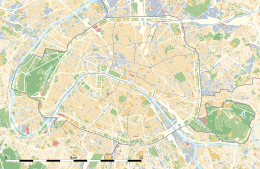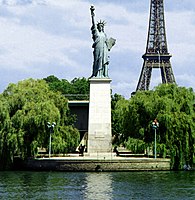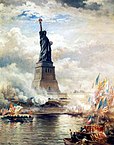geo.wikisort.org - Island
Île aux Cygnes (French: [il o siɲ]; English: Isle of the Swans) is a small artificial island on the river Seine in Paris, France, in the 15th arrondissement. It was created in 1827 to protect the bridge named the pont de Grenelle. It should not be confused with an earlier Île des Cygnes that was attached to the Champ de Mars in the late 18th century.
 The Île aux Cygnes as viewed from the top of the Eiffel Tower. The Statue of Liberty replica is just visible at the far end. | |
 Île aux Cygnes | |
| Geography | |
|---|---|
| Location | Paris, France |
| Coordinates | 48°51′10.03″N 2°17′00.95″E |
| Area | 0.013 km2 (0.0050 sq mi) |
| Administration | |
France | |
The uninhabited island is 850 metres (2,789 ft) long and 11 metres (36 ft) at its widest point, making it the third-largest island in Paris.[1] A tree-lined walkway, named L'Allée des Cygnes (Path of Swans), runs the length of the island.[2] Since 2012, there has been a public workout space with bicycles and a climbing wall underneath the Pont de Grenelle, close to a Statue of Liberty replica.[1]
The island is crossed by three bridges: the Pont de Grenelle, the Pont Rouelle and the Pont de Bir-Hakeim. It is served by the Passy and Bir-Hakeim Métro stations.

Statue of Liberty replica
A notable feature is a quarter-scale replica of Liberty Enlightening the World, commonly known as the Statue of Liberty on the Île aux Cygnes, is 11.50 meters (37 feet 9 inches) tall and faces west in the direction of its larger sibling in New York City. Inaugurated by President Marie François Sadi Carnot on 4 July 1889,[3] nearly three years after its US counterpart, it was donated to the city by the Parisian expatriate community in the US. A restoration project in 1986 marked the centennial of the original (as stated on the plaque).
The statue originally faced east, toward the Eiffel Tower, but it was turned west in 1937 for the world's fair hosted in Paris that year. At its base is a commemorative plaque, and the tablet in its left hand bears the inscription IV Juillet 1776 = XIV Juillet 1789, recognizing the American Independence Day and the French Bastille Day.
In 1998 to celebrate the "Year of France in Japan", the 14-ton statue was transported to Japan and displayed on Odaiba, an artificial island in Tokyo Bay, before returning to Paris the following year.[4] The statue was used as a plot point in the 1988 film Frantic and the 2007 film National Treasure: Book of Secrets.
- The replica Statue of Liberty
- Plaque on statue
References
- Frédéric Moussaïan (17 April 2014). "Île aux Cygnes". Michelin. Retrieved 21 November 2015.
- "L'Allée des Cygnes". Another Day in Paris. 27 March 2012. Retrieved 21 November 2015.
- "France's Liberty Statue". The New York Times. 5 July 1889. Retrieved 22 December 2009.
- "Statue illumination kicks off 'Year of France' event". The Japan Times. 28 April 1998. Retrieved 21 November 2015.
External links
 Media related to Île aux Cygnes at Wikimedia Commons
Media related to Île aux Cygnes at Wikimedia Commons
На других языках
[de] Île aux Cygnes (Paris)
Île aux Cygnes (.mw-parser-output .IPA a{text-decoration:none}il o siɲ; deutsch Insel der Schwäne) ist der Name einer künstlichen Seine-Insel im 15. Arrondissement von Paris.- [en] Île aux Cygnes
[fr] Île aux Cygnes (Paris)
L’île aux Cygnes, anciennement digue de Grenelle[1], est une île artificielle située sur la Seine, à Paris, entre les 16e et 15e arrondissements, et administrativement rattachée à ce dernier.[ru] Лебединый остров
Лебеди́ный остров, Лебя́жий остров (фр. Île aux Cygnes) — небольшой искусственный остров на Сене, расположенный неподалёку от Эйфелевой башни между 16-м и 15-м округами Парижа, хотя административно принадлежит последнему.Другой контент может иметь иную лицензию. Перед использованием материалов сайта WikiSort.org внимательно изучите правила лицензирования конкретных элементов наполнения сайта.
WikiSort.org - проект по пересортировке и дополнению контента Википедии


